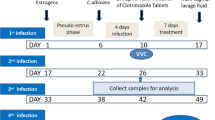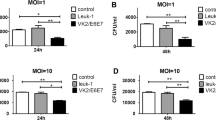Summary
To investigate the expression of vaginal IL-23 and its role in experimental murine vaginal candidiasis and its relationship with infection and immune status, immuno-competent (group A) and immuno-suppressed (group B) murine models of vaginal candidiasis were established in estrogen-treated mice. Non-estrogen-treated mice were used as controls (group C). The level of IL-23 p19 mRNA in murine vaginal tissue was determined by RT-PCR. Significantly increased levels of IL-23p19mRNA were observed on the 4th, the 7th and 14th day after inoculation in immuno-competent group when compared with that in control group (P<0.01,P<0.05), However, significant increase of IL-23 p19mRNA were only observed on the 7th day and the 14th day after inoculatuon in immuno-suppressed groups (P<0.05). On the 4th and 7th day, the levels of Il-23 p19mRNA were significantly increased in immuno-competent group, than those in immuno-suppressed group (P<0.05). Local IL-23 may play a role in the pathogenesis of murine vaginal candidiasis and has a protective function during infection. Low vaginal IL-23 level may correlate with the increased susceptibility toCandida albicans in immuno-suppressed group.
Similar content being viewed by others
References
Giorgio T, Stefan P, Robert A K. The IL-12 family of heterodimeric minireview cytokines: new players in the regulation of T cell responses. Immunity, 2003, 19:641–644
de Bernardis F, Santoni G, Boccanera Met al. Local anticandidal immune responses in a rat model of vaginal Infection by and Protection against Candida albicans. Infect Immun, 2000, 6:3297–3304
Zhao J J, Tong H, Zhang Z Het al. The expression of IL-4 and IL-12 in candida albicans vaginitis. Chin J Dermatol (Chinese), 2005, 38(3):178–179
Hunter C A. New IL-12 family members: IL-23 and IL-27, cytokines with divergent functions. Immunology, 2005, 5:521–531
Tan J, Li J W, Chen S Jet al. Susceptibility to vaginal candidiásis under different conditions in mice. J Huazhong Univ Sci Technolog Med Sci. 2005, 25(6):744–747
Fidel P L Jr, Lynch M E Sobel J D. Candida-specific Th1-type responsiveness in mice with experimental vaginal candidiasis. Infect Immun. 1993, 61:1900–1905.
Fidel P L Jr. Luo W, Steele Cet al. Analysis of vaginal cell populations during experimental vaginal candidiasis. Infect Immun, 1999, 67:3135–3140
Ye P, Rodriguez F H, Kanaly Set al. Requirement of interleukin 17 receptor signaling for lung CXC chemokine and granulocyte colonystimulating factor expression, neutrophil recruitment, and host defense. J Exp Med 2001, 194:519–527
Taylor BN, Saavedra M, Fidel P L Jr. Local Th1, Th2 cytokine production during experimental vaginal candidiasis: potential importance of transforming growth factor-b. Med Mycol, 2000, 38:419–431
Author information
Authors and Affiliations
Additional information
WU Yan, female, born in 1975, Doctor in Charge
This project was supported by grants from the Science Research Foundation of Health Department of Hubei Province (No. JXIB048) and the Janssen Research Foundation.
Rights and permissions
About this article
Cite this article
Yan, W., Zhijian, T., Zhixiang, L. et al. Local IL-23 expression in murine vaginal candidiasis and its relationship with infection and immune status. J. Huazhong Univ. Sci. Technol. [Med. Sci.] 26, 245–247 (2006). https://doi.org/10.1007/BF02895828
Received:
Issue Date:
DOI: https://doi.org/10.1007/BF02895828




